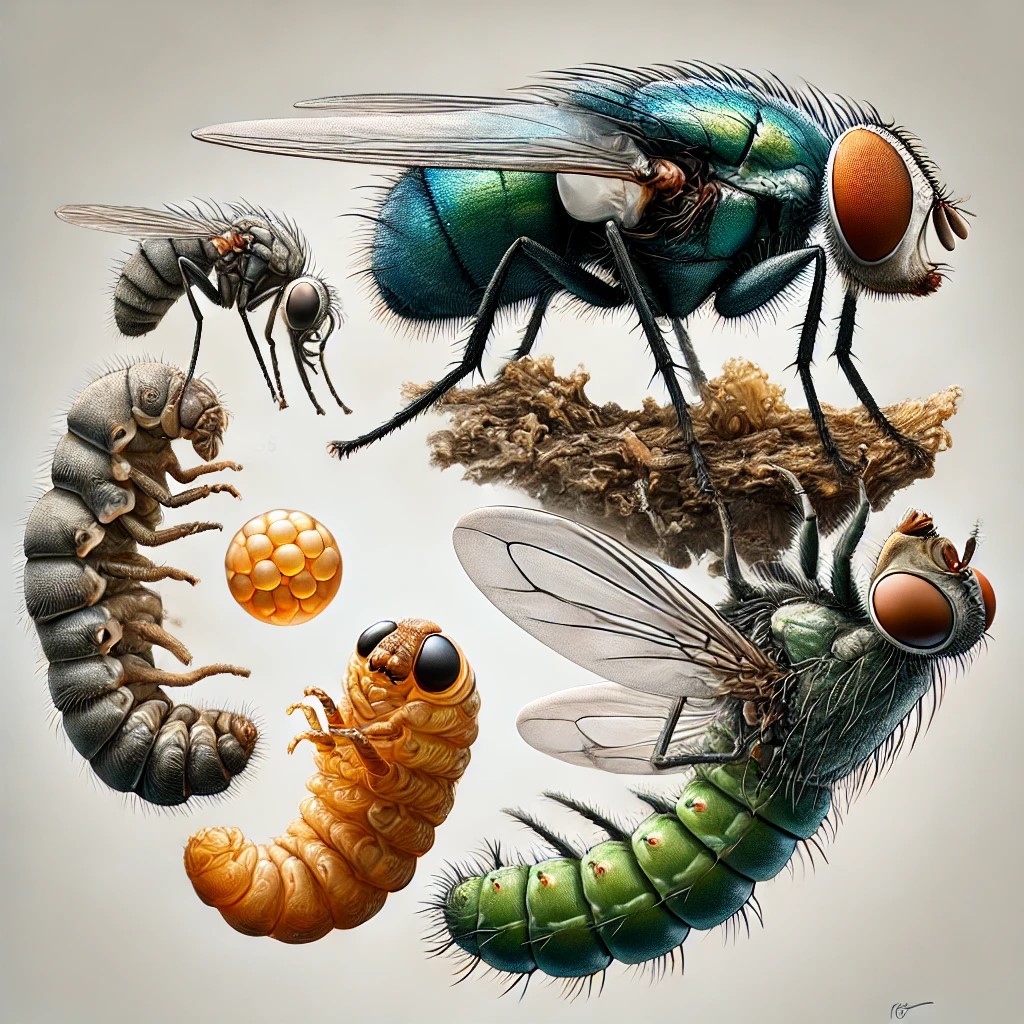
Flies are insects with a fascinating biology that has allowed them to thrive in almost every ecosystem on the planet. Their success lies in their rapid life cycle and high reproductive rate, making them one of the most abundant insect groups. Below, we will explore in detail their biological cycle and reproductive strategies.
The Life Cycle of Flies
Flies belong to the group of holometabolous insects, meaning they undergo a complete metamorphosis with four distinct stages:
1. Egg: The Beginning of Life
- Female flies can lay dozens or even hundreds of eggs throughout their lives.
- The eggs are usually deposited in decaying organic matter, feces, rotting fruits, or food.
- Depending on the species and environmental temperature, they hatch within hours or days.
2. Larva: Rapid Growth Phase
- Known as maggots or larvae, these small immature forms lack legs and eyes and feed voraciously to grow rapidly.
- They develop in humid environments rich in organic matter, such as garbage, manure, or decomposing carcasses.
- Their main function is feeding and storing energy for the next phase.
- In some species, the larval period lasts 3 to 7 days before entering the pupal stage.
3. Pupa: Transformation to Adult
- During this phase, the larva encases itself in a hardened cuticle (puparium).
- Inside the puparium, metamorphosis occurs, where the insect develops wings, legs, and eyes.
- This transformation can take between 3 and 10 days, depending on environmental conditions.
4. Adult: The Reproductive Stage
- Once metamorphosis is complete, the adult fly emerges, ready to feed and reproduce.
- Its lifespan varies by species, but generally, it can live between 15 and 30 days in optimal conditions.
- Most species reach sexual maturity in less than 48 hours, allowing them to begin their reproductive cycle immediately.
Reproductive Strategies: How They Ensure Survival
Flies have developed various strategies to guarantee reproductive success:
1. High Reproductive Rate
- Some species can lay up to 1,000 eggs throughout their lives.
- This allows them to quickly repopulate an area with suitable conditions.
2. Accelerated Development
- Thanks to their short life cycle, they can complete several generations in a year.
- This makes them highly adaptable insects to environmental changes and new food sources.
3. Selection of Optimal Environments
- Females seek locations with abundant organic matter to ensure the survival of their larvae.
- Many species prefer organic waste, carcasses, or rotting fruits, contributing to the natural recycling of nutrients.
4. Courtship and Mating Strategies
- In some species, males perform display flights or sound vibrations to attract females.
- Other species rely on chemical signals, such as pheromones, to locate compatible mates.
- After mating, females store sperm and can fertilize their eggs over several days or weeks.
Factors Affecting Their Reproduction
The reproduction of flies can be influenced by several factors:
- Temperature: Warm climates accelerate their development, while cold temperatures can slow or stop their cycle.
- Food availability: An environment rich in organic matter favors their proliferation.
- Competition and predators: Birds, spiders, and other predatory insects help control their populations.
Importance of the Fly Life Cycle in the Ecosystem and Pest Control
1. Their Role in the Ecosystem
- Fly larvae aid in the decomposition of organic matter, contributing to nutrient recycling.
- Some species act as accidental pollinators when visiting flowers for food.
- They serve as an important food source for birds, reptiles, and other insects.
2. Fly Management and Control
Although they fulfill valuable ecological functions, flies can become a public health problem by transmitting diseases. To control their presence in urban and commercial areas, the following strategies can be applied:
- Waste management: Eliminate food sources and decaying organic matter.
- Use of traps and physical barriers: Keep doors and windows closed or use mosquito screens.
- Biological control: Introduction of natural predators such as parasitic wasps that attack fly larvae.
- Chemical methods: Moderate use of insecticides or repellents when necessary.
Flies have evolved to become one of the most resilient and successful species on the planet. Their rapid life cycle, efficient reproductive strategies, and ability to adapt to almost any environment have ensured their persistence over millions of years. However, their uncontrolled proliferation in urban and commercial areas can pose a public health problem, making it essential to apply responsible management and control strategies.
At Eco Fauna Control, we understand the life cycle and biology of flies to offer effective control solutions. Our approach is based on sustainable and safe strategies, including:
- Specialized diagnostics: Identifying the fly species present and their source of proliferation.
- Ecological methods: Applying biological control techniques and environmental management to minimize their impact.
- Long-term solutions: Implementing preventive measures to reduce their presence without affecting the ecological balance.
If you need advice or professional services for fly and pest management, contact us. We are committed to providing safe and efficient solutions to protect the health of your home or business.
